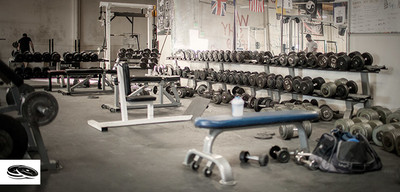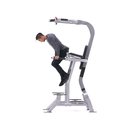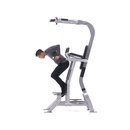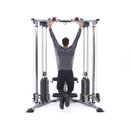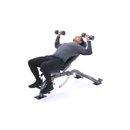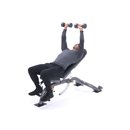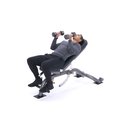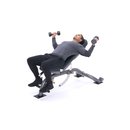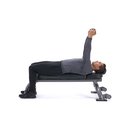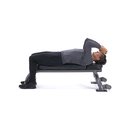You've got to hand it to Mike Mentzer. Say what you will about the man, savior or lunatic, he and his Jedis have definitely made a lasting impression on the training landscape and common gym knowledge. It seems like a lifetime ago when a bodybuilder's devotion was measured by the amount of time spent in the gym on a daily basis, and how many days a week he worked out. Now we know that our testosterone levels are shot after about an hour in the weight room, and doing much work beyond that point is counterproductive. We also know that 3 - 4 days a week are all that is necessary to get the body of your dreams. In fact, with all this new knowledge about lifting duration and frequency, we should all be growing like weeds with just 3 - 4 training sessions a week, right?
Well, as we all know, this is not the case. Just as many frustrated lifters exist today as did 10 - 20 years ago, when people devoted 20+ hours a week to the gym. The pendulum of opinion tends to swing mighty wide in bodybuilding circles between opposite viewpoints, such as the high vs. low-frequency debate, and rarely do people figure out that both viewpoints are valid, except when one is followed fanatically and exclusively. Most bodybuilders hit plateaus because they are too afraid to drastically change what they are doing in the gym and try something radically different than what the current trends in the mainstream fitness media tell them to do. Using an old technique of two-a-day workouts - literally lifting twice in one day - is a great way to mix things up, stimulating unprecedented muscle and strength gains, while helping to slash bodyfat.
Using two-a-days is not simply doing two random workouts in one day; this simplistic approach will quickly lead to overtraining and burnout. First, you must understand the proper way to structure a two-a-day program so that you don't overtrain yourself. In addition, your nutritional program will have to be modified to meet the increased energy demands and take full advantage of a two-a-day workout's unique fat-burning/ muscle-building potential.
Two-A-Day Advantages
Many strength coaches have touted the advantages of training twice in one day, and numerous competitive strength and power athletes train several times a day. Canadian strength coach Charles Poliquin has even suggested that we would all grow better if we could train twice a day on a consistent basis. Obviously, this would not be feasible for all of us, but everyone can still benefit from using this type of training program once in a while. One of the greatest benefits of this program lies in the obvious - the actual act of working out twice in one day.
Those of you who have experienced the added strength and muscle gains from adding a scientifically based post-workout meal to your nutrition schedule will automatically see the advantage of being able to fit in two post-workout meals in one day. By working out twice, you get your protein synthesis and other anabolic systems racing, and if you take full advantage of this by having two post-workout meals, you can start to see your gains skyrocket.
You will also find yourself able to train with more intensity. When faced with a full hour's worth of exercise, most of us will subconsciously conserve our energy early on to survive. If we do not, we find ourselves dragging through the latter portion of the workout. By splitting the total work up between two workouts, you can train with more overall intensity. Since intensity is a key to new strength and muscle gains, this too has obvious advantages.
Lastly, something for those of you who are trying to shed a few pounds of unsightly flab; It has been demonstrated on numerous occasions, both in the lab and in the real world, that when you split a workout up into two separate sessions on the same day you burn more total calories than if the whole workout had been done at the same time. This means a greater calorie deficit is created, and when you couple that with the added muscle that can be gained very quickly using this approach, you start to see that a two-a-day program is perfect for getting rid of fat, fast.
First Things First
First let's establish some ground rules for using the two-a-day workouts; While they can produce some dramatic results, you have to be very careful when using them. They are a very intense way to train, and for that reason should not be used continually. Most people don't have the time or motivation to train in this manner all the time and besides, your body can't take that much stress for indefinite periods of time. The two-a-day programs are best saved for busting through plateaus, or for those times when you are extremely motivated to train and the idea of going to the gym twice a day sounds appealing.
Even when you do use the two-a-day program, you have to be sure to limit its use to no more than two weeks in a row, and allow at least one week between cycles. This cannot be overstated, because I know all too well the mentality of most bodybuilders; if two-a-days work well, then three-a-days must be even better - and hey, while we're at it, let's just train like this all the time. Then they will over-train, burn out, then curse me for suggesting this training method; Two-a-days get swept under the rug for the rest of their training career. Don't make this mistake. The two-a-days will work, and work well, but you have to treat them with respect to fully appreciate their true potential.
Two-A-Day Basics
While you can tailor a two-a-day program to suit a variety of goals, some basic rules apply to all of the programs. While you don't have to be exact with the timing of your workouts, you do need to allow at least 6 hours between the two. Most people find it easiest to get in a workout in the morning before work and then catch another workout after work. Going on your lunch break and then again in the evening also works well, as long as you've waited at least 6 hours. If your workouts are much closer than this you will still be too fatigued to work out with optimal intensity during the second workout.
You also have to make sure you limit your workouts, excluding the warm-up, to no more than 40 minutes in length apiece. And yes, it is very important for you to perform a proper warm-up before and cool-down after working out. I know it's not the most popular part of a training program, but you must do it if you want to survive the two-a-days. You are asking a lot of your body's recuperative abilities with this program, so help them out a little. Nutrition and supplementation will play a big role, and we'll get into that in detail later, but a proper warm-up and cool-down will go a long way in speeding up recovery between workouts and lifting days.
The warm-up and cool-down is especially important for the recovery period between workouts. The light, rhythmic contractions associated with a proper cool-down - i.e. 5-10 minutes of light aerobic activity - helps the heart to return the pooled blood trapped in the pumped-up muscle groups back into the blood stream.
This speeds up the removal of lactic acid and other metabolic byproducts associated with pumping iron. Spending a few minutes stretching after the light aerobic activity will also help speed up this process. In addition, after chronic muscular contractions, like the kind that occur in the weight room, your muscles are slightly shorter. Although they will eventually return to their normal length, 5-10 minutes of stretching will greatly speed up this process as well.
Clearly the warm-up and cool-down are essential to making sure you are recovered enough to train again later. It's tough to get an effective second workout in when you are sore and stiff from the first workout. You will also tire quickly of the two-a-days if you are constantly sore and tired. Making sure you do all you can to recover as quickly and efficiently as possible is the key to this program's success.
Program Design
While the possible programs you can design with the two-a-day concept are literally endless, let's take a look at how a workout might shape up to get you started. Although there are several options for intensity variations between the two workouts, one of the most effective is lifting heavy in the first workout and lighter in the second.
This lets you not only train your very high threshold muscle fibers (the ones with the most strength and growth potential) with a high-intensity/ low-volume morning workout, but also fit in a lower-intensity/ higher-volume workout in the evening. Volume is also important when trying to coax additional growth from your muscles. Here's an example:
5-Day Split
- Day 1: Chest/Back
- Day 2: Legs
- Day 3: Rest
- Day 4: Arms
- Day 5: Rest


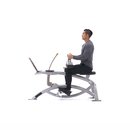
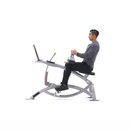


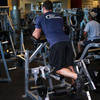

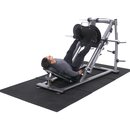
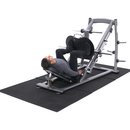
Day 3: Rest




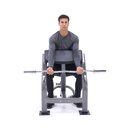
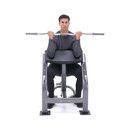
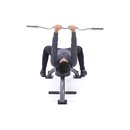
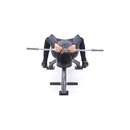


Day 5: Rest
Note: A five-day split will still fit into a two-week time frame if the fifth day is a rest day. That way the last workout day of the third rotation will fall on day fourteen, or exactly two weeks from day one.
Nutrition & Supplements
As I mentioned earlier, one of the key factors in getting the most from this program is recovery, and a huge part of that is proper nutrition and supplementation. How that shapes up for you will depend on what your current goals are. First, decide if you are doing this program to add strength and size, or to cut bodyfat.
If your goals are strength and size then your nutritional program is pretty easy - EAT! You will need extra protein, carbs and essential fatty acids at this time to maximize your strength and muscle gains, and all that adds up to extra calories - period. The easiest way to figure out how many calories you need to consume is to keep a food log for a few days. Most people will instinctively eat around the same number of calories a day, basically enough to maintain their current bodyweight. It's hard to know where you're going if you don't know where you are, so figure out where you're at right now with your diet.
Once you have estimated how many calories you consume on an average day, or your Basal Metabolic Rate (BMR), and then simply add some additional calories to this number. Try adding 2.5 calories per pound of lean body mass to your estimated BMR. This can be accomplished simply through the additional post-workout meal you will need to include. On your non-training, days fit in an extra protein shake somewhere. This would also be a good time to increase your protein intake to 1.5 - 2 grams per pound of bodyweight. I've found a macronutrient ratio of 60% carbs, 25% protein and 15% fat works very well for most people when on a two-a-day program for strength and muscle gains.
If you are training for fat loss, then you will want to be careful about creating too large a calorie deficit and sending your body into a starvation state. The two-a-day workouts will create a calorie deficit by themselves if you simply maintain your current food intake, and for most this is exactly what I would recommend. For you gung-ho types who want to truly maximize fat loss, then you can create a slightly larger deficit and speed up the fat-loss process, although you risk hard-earned muscle doing it.
First, keep a food log for a few days and estimate your BMR in the same way described above. Now simply subtract 2 calories per pound of lean body mass from your estimated BMR. Carefully monitor your weight and bodyfat percentage both before and after your first two-a-day cycle, and note how many pounds of fat you have lost. If you have lost much more than 2 - 3 pounds per week, or 4 - 6 total, then you have more than likely lost some muscle tissue also. In this case, you may need to add some calories back to your daily calories next time. If you have not lost at least 4 - 6 pounds, then you probably need to subtract a hundred or more calories a day for maximum benefits. Despite what some "gurus" may have you believe, nutrition is not rocket science and only a trial-and-error approach will tell you what works best for you.
Some may be tempted to try this program in conjunction with a ketogenic diet to really speed up fat loss. I would strongly advise against this approach. I am not a fan of keto diets to begin with, and the thought of someone trying to undertake a program as intense as this one without adequate fuel - i.e., carbs - does not sit well with me. Obviously someone will say "Consequences be damned" and try it anyway, but for the rest of you I would advise a more moderate approach along the 40% carb, 30% protein, 30% fat lines. The suggestion for increasing protein to 1.5 - 2 grams per pound of bodyweight would apply here also.
No matter what your training goal, make sure that your main supplement bases are covered by using a daily multi-vitamin/multi-mineral and taking at least 3 - 6 grams of vitamin C a day. An antioxidant formula and a specialty zinc/ magnesium supplement, like ZMA, would also be highly recommended. A good whey protein or MRP will make getting enough protein an easy task, and flax seed or fish oils are a convenient source of essential fatty acids. Unless you have these basic nutrients covered, then all the "specialty" supplements in the world will not help you maximize your gains.
The list of other supplements I would add to this list could get extensive, but since not many people can afford to take everything at once, I'll focus on a few main ones that could make a big difference. Again, both training objectives would use pretty much the same "specialty" supplements also, with the one exception being those seeking fat loss. They would want to use some sort of thermogenic to speed that up. The plain ECA stack or herbal equivalent is still a very good choice for this purpose.
Both groups would need to keep the attention levels high when in the gym, making a neurotransmitter enhancer an indispensable aid to get ready for the second workout. BioTest's Power Drive is the best supplement for this purpose that I have come across. And finally, since both ribose and our dear friend creatine have been shown to increase recovery and extend muscular endurance, those two - or a supplement containing them both - would most likely make a marked performance improvement.
So there you have it, the nuts and bolts of two-a-day workouts. Perhaps you've seen this type of program before, maybe even starting one at some point only to quit after a couple of days. It's certainly not for the casual fitness enthusiast. Only the most dedicated bodybuilder will make it through a full two-week cycle, because it's very easy to let life's distractions keep you from your two-a-day duties. But if you challenge yourself, and see at least one full cycle through - once you see how well this approach can work you'll find those distractions less "distracting." Don't fall victim to the same mentality most bodybuilders do; being afraid to try something new. Yes, it seems to fly in the face of common gym knowledge, but really, when did anyone ever get big and strong simply using common gym knowledge?

